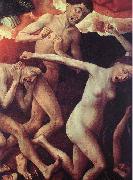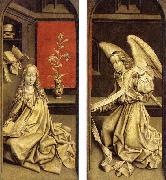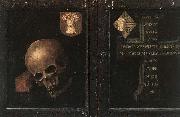All WEYDEN, Rogier van der Oil PaintingsNetherlandish Northern Renaissance Painter, ca.1400-1464 |
|||
 |
|||
|
|
|
||||||||||
|
|
||||||||||
|
The Last Judgment Gemälde IDENTIFIZIERUNG:: 63902 |
The Last Judgment 1446-52 Oil on wood Mus?e de l'H?tel Dieu, Beaune The detail shows a group of the damned. In Van der Weyden's time it was believed that lunatics were possessed by demons. Here, the figures of the damned are tortured and deformed by hatred and their faces distorted by madness. Gripped by a collective hysteria, they are unable to weep, but instead scream and fight, as their folly draws them on towards eternal punishment.Artist:WEYDEN, Rogier van der Title: The Last Judgment (detail) Painted in 1401-1450 , Flemish - - painting : religious 1446-52 Oil on wood Mus?e de l'H?tel Dieu, Beaune The detail shows a group of the damned. In Van der Weyden's time it was believed that lunatics were possessed by demons. Here, the figures of the damned are tortured and deformed by hatred and their faces distorted by madness. Gripped by a collective hysteria, they are unable to weep, but instead scream and fight, as their folly draws them on towards eternal punishment.Artist:WEYDEN, Rogier van der Title: The Last Judgment (detail) Painted in 1401-1450 , Flemish - - painting : religious |
|||||||||
|
|
||||||||||
|
|
Bladelin Triptych Gemälde IDENTIFIZIERUNG:: 63904 |
Bladelin Triptych 1480 Oil on oak panel Staatliche Museen, Berlin The exteriors of the wings of the Bladelin Triptych were probably not painted at first; an unknown painter added the Annunciation later, using as a model an engraving by Master FVB, probably active in Bruges 1480-1500, who had been strongly influenced by Rogier van der Weyden.Artist:WEYDEN, Rogier van der Title: Bladelin Triptych (exterior) Painted in 1401-1450 , Flemish - - painting : religious 1480 Oil on oak panel Staatliche Museen, Berlin The exteriors of the wings of the Bladelin Triptych were probably not painted at first; an unknown painter added the Annunciation later, using as a model an engraving by Master FVB, probably active in Bruges 1480-1500, who had been strongly influenced by Rogier van der Weyden.Artist:WEYDEN, Rogier van der Title: Bladelin Triptych (exterior) Painted in 1401-1450 , Flemish - - painting : religious |
||||||||
|
|
||||||||||
|
|
Braque Family Triptych Gemälde IDENTIFIZIERUNG:: 63905 |
Braque Family Triptych 1450 Oil on oak panel, 41 x 68 cm (central panel), 41 x 34 cm (wings each) Mus?e du Louvre, Paris The armorial bearings on the back indicate that this portable triptych was the property of Jehan Braque and his wife Catherine de Brabant, of Tournai, who were married in about 1450-51. Jehan Braque died soon afterwards, in 1452; his young widow, who did not marry again till 1461, must have commissioned this triptych in his memory. The Braque Triptych ranks among Rogier van der Weyden's most celebrated works. It is a small-scale work of the kind that were set upon portable altars in the oratories of wealthy individuals. When closed, it shows the classical vanity theme, a skull and a cross. Open, it displays images of Christ in the centre, and to either side - the Virgin, St John the Evangelist, St John the Baptist and Mary Magdalene. They are represented against a landscape that is rendered down to the finest detail, with its rivers and mountains, grass and leaves so precisely drawn they could almost be counted and tiny figures visible in the distance in the streets of imaginary towns - a favourite motif of the Flemish masters. Pictures showing busts of Christ and the Virgin had existed earlier north of the Alps, but a sequence of several saints shown half length seems to derive from a type of altarpiece found in Italy from the 13th century onward. The innovation is to place them in front of a wide, coherent landscape relating to the figures themselves not realistically, but in context. It stands for the entire world ruled by Christ and to which He descended incarnate as man, as described at the beginning of the Gospel of St John: "And the Word was made flesh and dwelt among us." If the dark exterior was a reminder of the inevitability of death, the wide, radiant interior with its saintly figures allowed the devout viewer to hope for salvation. Artistically, the triptych is very close to the Beaune Altarpiece. The head of the Virgin Mary, and in particular the head of Christ, are so like their counterparts in the picture of the Last Judgment that they must have been executed from the same cartoon (full-size design for a painting). It is not certain whether the work is entirely by Rogier's hand; the underdrawing reveals thin lines not at all typical of him, and perhaps done with a pen instead of Rogier's usual brush. There are also some differences in the artistic execution: the Virgin's face, for instance, looks waxen, and inflexible around the eyes by comparison with the wonderful, tenderly painted, and lifelike Mary Magdalene, which is among Rogier's finest works.Artist:WEYDEN, Rogier van der Title: Braque Family Triptych Painted in 1401-1450 , Flemish - - painting : religious 1450 Oil on oak panel, 41 x 68 cm (central panel), 41 x 34 cm (wings each) Mus?e du Louvre, Paris The armorial bearings on the back indicate that this portable triptych was the property of Jehan Braque and his wife Catherine de Brabant, of Tournai, who were married in about 1450-51. Jehan Braque died soon afterwards, in 1452; his young widow, who did not marry again till 1461, must have commissioned this triptych in his memory. The Braque Triptych ranks among Rogier van der Weyden's most celebrated works. It is a small-scale work of the kind that were set upon portable altars in the oratories of wealthy individuals. When closed, it shows the classical vanity theme, a skull and a cross. Open, it displays images of Christ in the centre, and to either side - the Virgin, St John the Evangelist, St John the Baptist and Mary Magdalene. They are represented against a landscape that is rendered down to the finest detail, with its rivers and mountains, grass and leaves so precisely drawn they could almost be counted and tiny figures visible in the distance in the streets of imaginary towns - a favourite motif of the Flemish masters. Pictures showing busts of Christ and the Virgin had existed earlier north of the Alps, but a sequence of several saints shown half length seems to derive from a type of altarpiece found in Italy from the 13th century onward. The innovation is to place them in front of a wide, coherent landscape relating to the figures themselves not realistically, but in context. It stands for the entire world ruled by Christ and to which He descended incarnate as man, as described at the beginning of the Gospel of St John: "And the Word was made flesh and dwelt among us." If the dark exterior was a reminder of the inevitability of death, the wide, radiant interior with its saintly figures allowed the devout viewer to hope for salvation. Artistically, the triptych is very close to the Beaune Altarpiece. The head of the Virgin Mary, and in particular the head of Christ, are so like their counterparts in the picture of the Last Judgment that they must have been executed from the same cartoon (full-size design for a painting). It is not certain whether the work is entirely by Rogier's hand; the underdrawing reveals thin lines not at all typical of him, and perhaps done with a pen instead of Rogier's usual brush. There are also some differences in the artistic execution: the Virgin's face, for instance, looks waxen, and inflexible around the eyes by comparison with the wonderful, tenderly painted, and lifelike Mary Magdalene, which is among Rogier's finest works.Artist:WEYDEN, Rogier van der Title: Braque Family Triptych Painted in 1401-1450 , Flemish - - painting : religious |
||||||||
|
|
||||||||||
|
|
Braque Family Triptych Gemälde IDENTIFIZIERUNG:: 63906 |
Braque Family Triptych 1450 Oil on oak panel, 41 x 68 cm Mus?e du Louvre, Paris The dark exterior was a reminder of the inevitability of death. The left frame bears a saying in French uttered by the skull: "See, you who are so proud and avaricious, my body was once beautiful but now is food for worms.." This skull is intended as a "likeness" of the dead Jean Braque, whose coat-of-arms is shown above it, reminding viewers of their mortality. The inscription on the cross on the right is from the apocryphal Book of Ecclesiasticus (Chapter 41, 1-2) and laments the bitterness of death.Artist:WEYDEN, Rogier van der Title: Braque Family Triptych (closed) Painted in 1401-1450 , Flemish - - painting : religious 1450 Oil on oak panel, 41 x 68 cm Mus?e du Louvre, Paris The dark exterior was a reminder of the inevitability of death. The left frame bears a saying in French uttered by the skull: "See, you who are so proud and avaricious, my body was once beautiful but now is food for worms.." This skull is intended as a "likeness" of the dead Jean Braque, whose coat-of-arms is shown above it, reminding viewers of their mortality. The inscription on the cross on the right is from the apocryphal Book of Ecclesiasticus (Chapter 41, 1-2) and laments the bitterness of death.Artist:WEYDEN, Rogier van der Title: Braque Family Triptych (closed) Painted in 1401-1450 , Flemish - - painting : religious |
||||||||
|
|
||||||||||
| VORHERIGER KÜNSTLER NÄCHSTER KÜNSTLER | ||||||||||
|
|
||||||||||
| WEYDEN, Rogier van der | ||||||||||
| Netherlandish Northern Renaissance Painter, ca.1400-1464 | ||||||||||
|
|
||||||||||
|
KONTAKTIEREN Sie UNS |









